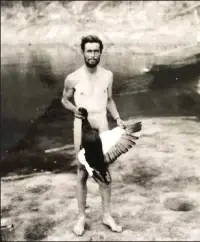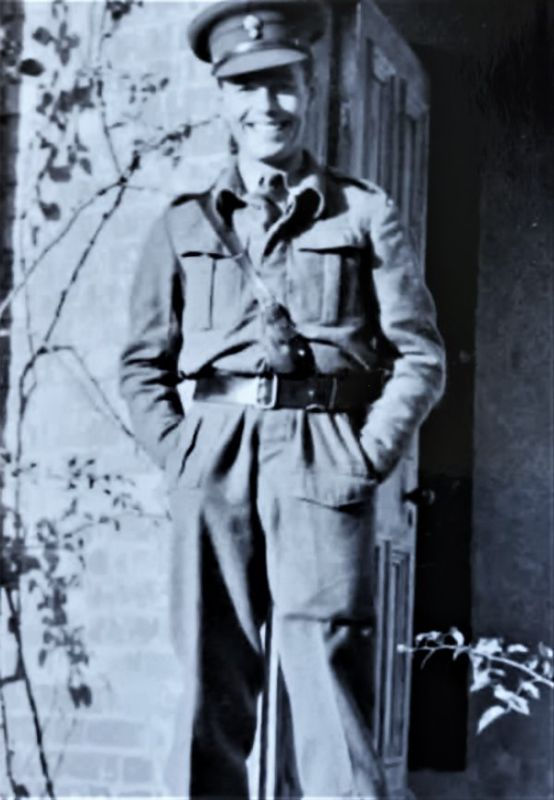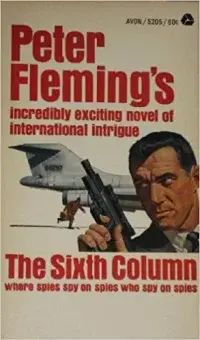485 Peter Fleming
- Alan Billyeald

- 14. juni
- 6 min lesing
Researched and written by 1043 Harry-Sam Selikowitz
På et møte i klubben nevnte Trampesjefen et tidligere medlem 485, Peter Fleming 1
som ble medlem i 1939. Han var storebror av Ian Fleming, forfatter av James
Bond. Jeg visste fra før at Peter Fleming var i Namsos, som spion, under den
mislykkete Norwegian campaign i 1940. 2

Hvordan kunne han bli medlem av vår klubb i juli 1939? Hvem var denne mannen,
vårt medlem, som tilsynelatende spilte en rolle i en tid hvor verden sto i flammer.
Jeg ble veldig nysgjerrig og måtte følge opp og her er det foreløpige resultatet. Jeg er
ennå ikke i havn, men jeg vet at Fleming holdt en forelesning in Oslo i februar 1939
og vet også hvor det var. Dette følger jeg opp.
Peter Fleming was born in 1907 and graduated at Oxford with a first-class degree in
English. He was the older brother of Ian Fleming of James Bond fame.
His travels
In April 1932 Fleming replied to an advertisement in the personal columns of The
Times "Exploring and sporting expedition leaving England June to explore rivers
central Brazil”. 3
Fleming´s book about the expedition, Brazilian Adventure, was
first published in 1933 and we have the book in our library.( bok nr 63 hylle A3).

He continued travelling from Moscow to Peking via the Caucasus, the Caspian,
Samarkand, Tashkent, the Turkish Railway and the Trans-Siberian Railway to Peking as a special correspondent of The Times. His experiences were written up in One´s Company (1934). He then went overland in from China via Tunganistan to India on a journey written up in News from Tartary (1936). We also have that book in our library. (bok nr. 64 hylle A1).
These two books were combined as Travels in Tartary: One´s Company and News from Tartary (1941).
The Peter Fleming Award, worth £9,000, is given by the Royal Geographical
Society for a "research project that seeks to advance geographical science”.
A real tramp!
Fleming also became literary editor of The Spectator.
The Second World War
Peter Fleming, became a reserve officer in the Grenadier Guards in 1939 and was
recruited by the War Office research section investigating the potential of irregular
warfare (MIR). His initial task was to develop ideas to assist the Chinese guerrillas
fighting the Japanese, and was part of the Norwegian campaign in 1940.
The Norwegian campaign involved the attempt by Allied forces to defend
northern Norway coupled with the Norwegian military resistance to the countrys`
German invasion.
On April14th Fleming landed, as an intelligence officer, in a flying boat in
Namsenfjorden. Fleming with the codename “Flea” was on a mission to prepare the
path for Allied troops in central Norway. A spy. He wrote in a secret report to the War
Office after a few marines arrived: “It is my belief that we are the first British troops to
land in Norway”. 2

General Adrian Carton De Wiart arrived to command the landings and the push
towards Trondheim. De Wiart, a veteran of the great war and who according to
Fleming had “only one eye, only one arm and rather surprisingly, only one Victoria
Cross». (3, p 224) The landings were accomplished successfully, but the allied
forces, once discovered, came under heavy air attack. De Wiart sent Fleming back to
Britain to report on the situation and to request orders. When he arrived in London,
he found out that he had been reported dead. Fleming commented in his diary about
the Norwegian campaign: “The errors were gross, muddled so pervasive and the
whole affair over so quickly that there wasn’t a great deal to be learned from it”.
A British, French and Polish expeditionary force of 38,000 troops landed in the north,
but made a rapid strategic retreat and Namsos was evacuated. On 29 April, an
evacuation convoy of destroyers, three British and one French, left Scapa Flow in
Scotland under the command of Lord Louis Mountbatten
Peter Fleming`s report was probably one of the factors which led to the evacuation
decision, but not only that, as it was believed that the report which was deposited to
the War Office, contributed in no small way to the downfall of Chamberlain as Prime
Minister, who resigned on May 10 th. He was replaced as Prime Minister by Winston
Churchill.
Winston Churchill was a father figure for Peter Fleming as he and his father Valentine
were in the same regiment, the Oxfordshire Hussars.
His clubs
Travellers Club
Peter Fleming became a member of our club in July 1939, with the number 485.
The Bullingdon Club
The other club that he was a member of was the Bullingdon Club in Oxford,
established in 1780, where he became a member in 1928. Like ours, an all-male
club, but otherwise, to put it mildly, somewhat different. The Bullingdon Club is an
elite drinking/dining club at Oxford university, with an acknowledged history of
property destruction when inebriated. The Bullingdon Club´s members have become
notorious over the years for vandalizing restaurants and trashing students
rooms. The club members involvement in criminal violence, and their code of omertà
- protecting each other - seems like a poor basis for which to select people for public
office. But as we see from the membership, this did not hinder them from
infiltrating establishment positions. 4
Some of the other members:
Royalty
Fredrik VII of Denmark - Edward VII of the United Kingdom of Great Britain and
Ireland - Rama VI, King of Siam - Edward VIII of Great Britain, Northern Ireland -
Fredrik IX of Denmark
Politicians
Lord Randolph Churchill (Chancellor of the Exchequer father of Sir Winston Churchill
- Cecil Rhodes Prime Minister of the Cape Colony - Edward Wood, 1st Earl of
Halifax Foreign Secretary (1938–1940) - John Profumo, Secretary of State for War
(Profumo scandal, Christine Keeler) - Boris Johnson, Prime Minister of the United
Kingdom - David Cameron, Prime Minister of the United Kingdom.
James Bond
Ian Fleming drew some of his inspiration for 007 and his fictional espionage world
from the unique knowledge he acquired during his own real-life role as an
Intelligence officer in London during the war. But his older brother Peter, chose to
organize clandestine saboteur groups (bands of guerrillas to resist the enemy if
England had been invaded in 1940) and was part of British Military Intelligence. Both
men ‘networked’ in the same social circles, picking up detailed knowledge of the
clandestine world of spies and secret agents. In contrast to Ian, though, Peter did see
some direct physical action in the field, and as we have seen, was part of the small
military force that operated in Norway for the brief duration of the (unsuccessful)
Norway campaign in April 1940. Peter was able to use small explosives to carry out
some daring sabotage operations as the British forces retreated.
When Ian Fleming very sadly passed away aged just 56 in 1964, Peter Fleming took
an active role in protecting his brother’s literary legacy. including the James Bond
novels.

Some scholars have suggested that a spy novel written by Peter may have given Ian an added sense of urgency to start his own spy novel series and break free from his
brother’s shadow. Peter Fleming’s satirical book The Sixth Column (1952), written
and published just before Ian’s first Bond novel Casino Royale appeared, had an
espionage theme at its heart and was dedicated to Ian. Ian Fleming perhaps wanted to demonstrate that he, too, could write best-selling novels, but in a way that treated the world of spying in a more gritty and realistic fashion, but also with a dash of
glamour. 3
Moreover, it has been suggested that Peter may have played a role in changing the
name of M’s devoted secretary. In the first draft of Casino Royale, she was named
‘Miss Pettaval’: according to recent evidence, Peter apparently suggested that this name be changed to
‘Miss Moneypenny’. And it is also now clear that Peter was keen to help proofread his brother Ian’s Bond manuscripts, taking such close care and attention to refine the details and help Ian avoid mistakes that the Bond author began to refer to Peter as ‘Dr. Nitpick’!
Peter Fleming died on 18 August 1971 from a heart attack while on a shooting
expedition in Scotland, with a Norwegian flag brought back from Namsos beside his
bed. His body was buried in the graveyard of St Bartholomew’s Church in Nettlebed,
(3) His gravestone has verses he wrote himself:
He travelled widely in far places;
Wrote, and was widely read.
Soldiered, saw some of danger´s faces,
Came home to Nettlebed.
The squire lies here, his journeys ended –
Dust, and a name on a stone –
Content, amid the lands he tended,
To keep this rendezvous alone.
R.P.F.
A real Tramp!
It is pretty cool that a member of Travellers´ Club was instrumental in the evacuation
from Norway during the Norwegian campaign in 1940 and also contributed to
Winston Churchill becoming Prime Minister. This in addition to that the clandestine
work of Peter Fleming was an inspiration to the creation of James Bond.
Refences
1 Travellers` Club Medlemsmatrikkel 2018
2 Nicholas Shakspeare. Six Minutes in May. How Churchill unexpectedly became
prime minister. Vintage, London 2017
3 Duff Hart-Davis. Peter Fleming. A Biography. Jonathan Cape, London 197
4 The New York Times. "Bullington Club Too Lively For Prince of Wales". 1 June
1913.





Meget interessant. Det opplyses i Tramp julen 1957 at han er livsvarig medlem. Jeg finner imidlertid ingen referanse til han i Tramp hverken før eller etter dette. Hva kan ha vært hans tilknytning til Norge og TC før krigen?
fantastisk historie Harry-Sam, mange takk